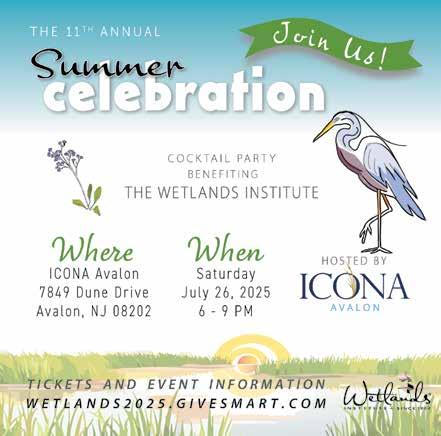Black Skimmers: A Seven Mile Island Showcase
by Dr. Lisa Ferguson, Director of Research and Conservation
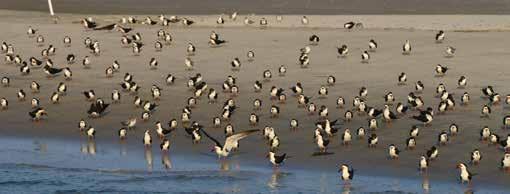
They bark. They merp. They hang out in large groups by the water in the summer heat, and when they lift and swirl as a flock they can catch your breath. In a unique approach to fishing, they glide over still waters of the slack tide with the lower, longer bill scraping the surface, tracing lines as they search by feel for food. Their large eyes with cat-like pupils and long, slender wings equip them to work the waters under dim light when the fish make their vertical migration, putting them within reach of that skimming bill.
We are lucky to showcase a colony of Black Skimmers at the end of Stone Harbor Point – one of only a few spots in New Jersey where this state-endangered seabird nests. In fact, Stone Harbor Point hosted over a third of the 2,341 skimmers nesting in New Jersey in 2024. Skimmers tend to seek locations far from the crowds that might disturb them as they warm eggs, guard chicks, and catch rest on the shorelines. But if the conditions are right, they will nest on busy beaches and in the marsh grasses too. Their nest is a simple shallow scrape dug by foot, making the 3 – 4 eggs they so carefully tend vulnerable to flooding from storms, tidal surges, land and aerial predators, and many of the activities we love the beach for as well. In 2024, there were only three active colonies in the state, the lowest number on record since 1976, which speaks to just how important it is to protect these sites.
Since 2015, Black Skimmers have been a focus of the Research and Conservation team’s work at The Wetlands Institute (TWI). Each summer, in partnership with the Borough of Stone Harbor, our stewards keep a protective eye on the skimmers and their beach-nesting neighbors like Piping Plovers, American Oystercatchers, and Common Terns. The stewards educate beach-goers and direct people to routes less disruptive to the birds that are simply trying to raise their young in a crowded world. This mission gets increasingly challenging as the young hatch and test their legs on the open beach, often seeking out the water’s edge where the sand and updrafts are cooler. It gets hot on the upper beach – sometimes lethally so – which is why giving skimmers and other beach-nesting birds the space to protect their nests and raise young is so critical.
If you take a close look at a lineup of skimmers, you might see some touting a brightly colored leg band. Since 2017, our trained staff has been banding skimmers (under our federal and state permits) with a white three-character code engraved in a blue band – New Jersey’s color in a system of band colors coordinated by state. We work in concert with New Jersey Fish and Wildlife (NJFW) on this project so we can better understand the travels, habits, and survival of this species. Adult skimmers often return to the same colony where they spent their days as chicks; skimmers banded as chicks in New Jersey regularly
return here to nest and raise their young.
We exchange information about the banded skimmers we see with the US Geological Survey’s Bird Banding Laboratory and a network of partners and volunteers up and down the coast. We now have observations of 70% of the 364 skimmers banded in New Jersey. The vast majority have been spotted along the east coast of the United States, but we have reports from as far away as Mexico, Cuba, and Nova Scotia. We are learning which beaches New Jersey skimmers prefer for rest during our winter months (turns out Florida), which rich marsh systems they feed in on their journeys north and south, and what threats they might be exposed to along the way. When hurricanes strike the coast of Florida, we worry about our New Jersey skimmers.
With backing from NJFW and philanthropic supporters of TWI, we have deployed lightweight GPS transmitters on twenty skimmers to study where they go in greater detail. These tracking devices are giving us insights into foraging locations, nocturnal roosts, and movements of individuals between colonies.
These studies are helping to protect this species in New Jersey and across their range. The choices you make are helping too. What more can you do?
• Walk around flocks of birds.
• If your movement disturbs their movement, you are too close.
• Exercise your dogs away from areas where protected species nest and rest.
• Look for and report bands. It’s a fun and rewarding way to spend your time and help science! Plus you’ll learn the details of the birds you report.
• Be mindful of your wake when piloting through the back bays and along coastlines. Vulnerable chicks and nests might be out of sight but not out of reach of your wake.
Deborah A. Hays, Chair
James Donohue, Vice-Chair
Hank Schellenger, Treasurer
Annie Ulichney, Secretary
Raymond Burke
Timothy Jon Clay
John Flynn
William Hankowsky
Margaret McAllister
John Millar
Staff
Leadership
Jeannie Morris
Liz Thomas
Jon Tullis
Amy Welsh
William Wermuth
Francis J. White III
Dr. Lenore Tedesco, Executive Director
Dr. Lisa Ferguson, Director of Research and Conservation
Jim Frick, Director of Finance and Operations
Brooke Knapick, Director of Educational Program Development
Research & Conservation
Julie Blum, Research Scientist
Samantha Collins, Research Scientist
Meghan Kolk, Conservation Scientist
Bailey Sanders, Research & Conservation Coordinator
Brian Williamson, Research Scientist
Education
Francesca Jacobs, Environmental Educator
Abbygayle Liles, Aquarist/Environmental Educator
Erin Rawls, Outreach Coordinator
Development & Communications
Devin Griffiths, Marketing and Communications Specialist
Leah Satterfield, Development Associate Finance
Terrie Campbell, Finance Administrator
Christine Whaley, Finance Analyst Administration
Mary Beth Ciccarone, Administrative Coordinator
Kimberly Dmytro, Tidepool Shop Manager
Michael Fridmann, Facilities Manager
Visit Us
Hours: May 19 - September 14, open daily 9:30 to 4:30.
General Admission: Members: Free. Non-members: $12 Adults, $10 Children 4-12.
Marsh M usings
by Dr. Lenore Tedesco, Executive Director
As we roll into another summer down at the shore, I am reminded once again how lucky we are. Summer is a time of incredible energy, and The Wetlands Institute is buzzing with excitement and discovery. Our education programs are peaking with summer visitors, visitor programs, guided nature walks, and on-the-water kayak, paddleboard, and Skimmer tours – and the undergraduate interns are here bringing their own burst of energy to the season.
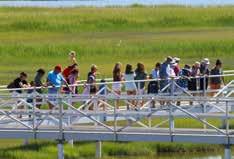
The research and conservation department is very busy working with the interns on their projects, working on terrapin conservation efforts, monitoring the salt marsh response to restoration efforts, coordinating the reTURN the Favor program volunteers and conducting horseshoe crab surveys, stewarding the beaches to protect beach nesting birds and educate the public on their needs, and working on several grant-funded projects to track and understand the needs of wading birds on the marsh islands and along the Delaware Bay.
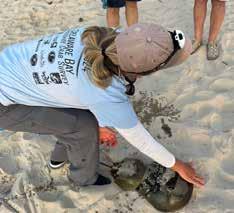
While we are truly busy all year ‘round, summer brings a different busyness. In many ways, it’s the time when all of our efforts come together in a fantastic display
of connections. It’s a wonderful time to be at The Wetlands Institute because the sense of community and connections are felt by all of us. Schoolchildren releasing the diamondback terrapins they helped care for throughout the year is truly a treasured time when they take steps toward becoming stewards of these fragile marshes and make lasting connections to this community of caring. The gleeful ah-ha moments joyously shared (often loudly) by children in Summer Nature Programs are always a delight and make me hopeful for a future filled with environmentally aware and engaged protectors of these special places. The bonds and connections formed among undergraduate interns in both the Environmental Education and Coastal Conservation Research Program are remarkable as they discover the impact they can have by their personal actions, which is a testament to the importance of these opportunities, and watching how they develop over the course of their work is inspiring.
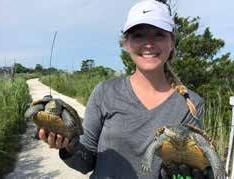
There are so many ways that The Wetlands Institute’s work, programs, and the opportunities we provide collectively build a community of caring and stewardship. It’s really magical, and the most incredible part is that everyone can be a part of it. Whether it starts with a visit, guided walk, participation in a program, volunteering, or purchasing a membership, TWI is a welcoming place that is just waiting for you to be a part of the community of education, conservation, and caring that brings lifelong enrichment to all that join us. Come for a visit and join our community. If you are already a part of the community, bring a friend and give them the gift of community, too.

Investing in the Future
by Elizabeth Hefner, Development Team
At The Wetlands Institute, our scientists work tirelessly to discover and develop groundbreaking solutions to the threats that face wetland ecosystems, their wildlife, and our coastal communities. Key projects range from a more than 30year ongoing effort to study and protect diamondback terrapins, to volunteerdriven rescue work that has saved more than 1 million horseshoe crabs, to sophisticated research on coastal birds and their changing habitat needs. We create connections for more than 17,000 visitors and more than 14,000 schoolchildren each year. Our wetlandfocused educational programs help make an informed citizenry to steward these resources for future generations.
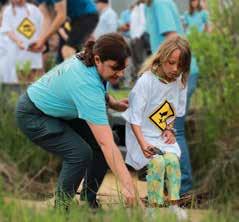
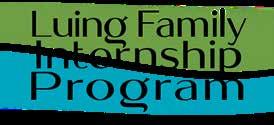
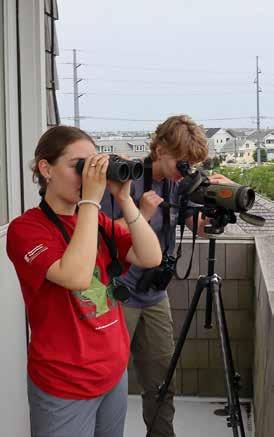
The Institute’s mission spans three interconnected pillars: Conducting applied research to guide our conservation efforts and evaluate their effectiveness; undertaking conservation projects that put research insights to work, providing volunteers with actionable opportunities to engage in protecting wildlife and preserving habitat; and delivering education programs that connect people to the wetlands and provide the awareness and the spark that inspires them to take action.
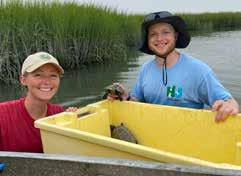
Individually, programs in each of these three areas are essential. Together, they make The Wetlands Institute virtually unique. They allow us not only to carry out scientific work of value, but also to set the stage for countless “ah-ha” moments that meaningfully connect people to nature.
Just in time for the summer field season, we’ve welcomed five 2025 CCRP interns to join our Research and Conservation department for a 10-week adventure, conducting independent research projects and contributing to our studies on diamondback terrapins and coastal birds. We are excited to have an intern returning for a second summer with us as well! Please join us in welcoming:
Joey Brace, Florida Gulf Coast University
Mary Castellani, Rutgers University (2nd year intern)
Sarah Davidson, Widener University
Kristen Kallok, Barnard College of Columbia University
Katelyn Seay, Stockton University
These moments can lead to life-long— even multigenerational—engagement, turning visitors and volunteers into stewards of our wetlands and partners in achieving large-scale, lasting change.
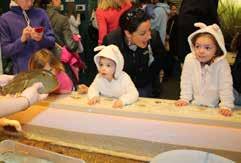
Support from our donors has created a sea change for the coastal ecosystem, filled with hope that we can have healthy wetlands teeming with life for future generations. There is so much more that we need to do. How much we can achieve depends on support from visionary donors like you.
Your investment in The Wetlands Institute is an investment in the increased resilience of our marshes, the wildlife that depends on them, and the coastal communities they protect. It enables The Wetlands Institute to respond to new challenges and seize new opportunities.
Let the adventure begin! Our Environmental Education Interns are spending 12 weeks leading public education programs and designing their own independent projects, all while immersing themselves in the unique environment of the surrounding saltmarsh and barrier islands. Already off to a great start, they look forward to meeting you:
Wiley Koskinen, Goucher College
Alyssa Margerum, Kutztown University
Aubrey Smith, Montclair State University
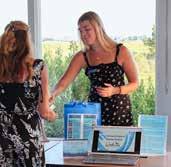
Mark your calendars and join us to see the results of their summer projects at The Wetlands Institute’s Annual Intern Symposium on August 4!
Learning in Action: Meet Cheyenne Hamby
by Brooke Knapick, Director of Educational Program Development
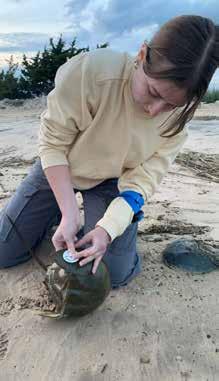
The Wetlands Institute is proud to host Cheyenne Hamby as an Aquarium Intern. Cheyenne is a senior at Lower Cape May Regional High School (LCMR) and a participant in the final year of their Structured Learning Experience Program. Since September, as part of her academic schedule, Cheyenne has been gaining handson experience working in our Secrets of the Salt Marsh Aquarium two afternoons a week. During her time at The Wetlands Institute, Cheyenne has been learning how to feed animals, clean and maintain saltwater and turtle tanks, assist with exhibit maintenance, collect food and display animals, and perform other essential functions. Below is a brief interview with Cheyenne that explores her passion for marine science and her experience here at The Wetlands Institute.
Q: What interests you the most in marine science?
A: I am most interested in learning more
about the individual species and the things that make them unique because they are so vastly different but so similar too. It’s fascinating!
Q: What are your plans for after graduation?
A: After graduation, I plan to go to Texas A&M University at Galveston for Ocean Engineering, and then hopefully pursing my doctorate degree also in Ocean Engineering.
Q: What do you hope to take away from this experience?
A: I would love to take away a lot of the knowledge that I have learned about our oceans and overall everything that I have learned about the {salt marsh} environment.
Q: What is your favorite marine animal?
A: Oh, tough question! Why would you do this to me?! {laughs and contemplates} The blue whale because they are so large and majestic.
Partnership in Action: Helping Hands for Terrapins
by Brian Williamson, Research Scientist
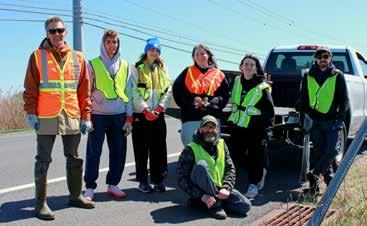
Since 1990, The Wetlands Institute has worked with Joe Grotolla, a science teacher at Lower Cape May Regional High School, to help protect local terrapins. Joe, and more recently Travis Davis, help raise terrapin hatchlings in their classroom as part of our head-starting project, and Joe has been an active participant in our Turtle Patrol, aimed at tracking terrapin road mortality and directly rescuing terrapins from roads for 35 years.
As a part of this effort, each year Joe brings a cadré of LCMRHS students who volunteer their time helping our staff with seasonal terrapin barrier fence maintenance. We assess and repair this fencing every year, and these dedicated students
make our job much easier – and since the fencing is designed to keep terrapins off the roadways, their work makes a real difference for the turtles as well.
Our partnership with both Joe Grotolla and Travis Davis at LCMRHS has been invaluable to our mission, helping us understand and protect local terrapin populations, and we are proud to be able to continue working with them to advance our mission.
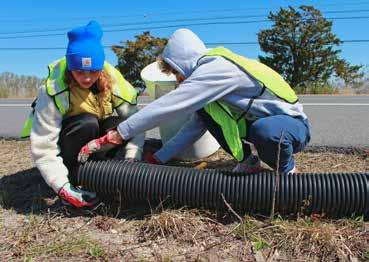

Summer Happenings
The Wetlands Institute will be open daily from 9:30am-4:30pm with all-day activities from June 16-September 1, 2025! Unless otherwise stated, all activities are free with admission and occur onsite at The Wetlands Institute. For more information, visit wetlandsinstitute.org/events.
Exploration Point 9:30 AM Monday
Bring your buckets! Meet at the trailhead at 122nd Street in Stone Harbor and explore Stone Harbor Point for awesome seashells, cool birds, and fun things that live under the sand. Suggested $3 donation to The Wetlands Institute.
Creature Feature
11:15 AM & 1:15 PM Monday - Friday
During this live animal presentation, get up close and personal with turtles, fish, crabs, sea stars and urchins, mollusks, horseshoe crabs, or the popular animals of Finding Nemo
Get your feet wet (or wear waders!) as you discover what swims in the back bays. Help us drag a seine net through the water to find crabs, shrimp, fish and more. Catch o’ the Day Monday, Wednesday, Friday 3:15 PM
Salt Marsh Safari
10 AM, 12 PM & 2 PM 11 AM
Watch our award-winning film, Secrets of the Salt Marsh, then join us for an interpretive marsh walk along our elevated walkway and onto the dock overlooking Scotch Bonnet creek!
Totally Turtle Tuesday
11 AM - 4 PM Tuesday
Every Tuesday is a day with the turtles! Meet them up-close at our Turtle Basking Station, learn about our latest research during our Creature Feature presentations, make unique turtle crafts, and join us for a special terrapin release during our noon Salt Marsh Safari.
Aquarium Feeding
3:15 PM 2:15 PM Tuesday and Thursday Saturday
Help us feed the local marine life! We will open up feeding three times each week so you can see the burrfish eating crabs and the horseshoe crab gobbling shrimp.
Dune and Beach Walk 9:30 AM Wednesday
Meet at 48th Street and Dune Drive in Avalon for an interpretive walk along the maritime forest and dune trails to learn about the flora and fauna that call this area their home. Free to attend and generously sponsored by Avalon Free Public Library.
Horseshoe Crab Mania Thursday
11 AM - 4 PM Thursday
Thursdays are for the Horseshoe Crabs! Meet these ancient animals up-close during our Creature Feature presentations, make horseshoe crab take-home crafts, and join us for a special horseshoe crab hatchling release during our noon Salt Marsh Safari.
Hooked on Fishing
Go fishing! We’ll teach you how to bait a hook, cast a line, catch a fish and reel it in. We’ve even got fishing poles and bait.
Seashell Sunday
10 AM Sunday
Seashells at the seashore! Join us to learn all about seashells, how to collect them without harming the environment, and touch an assortment of live mollusks and cool artifacts.
Crabbing at the Dock
Drop a line in the water and see what pinches it! We’ll provide the bait and handlines - You reel in the blue crabs!
Stone Harbor Bird Sanctuary Tour
10 AM Saturday & Sunday ( July 5 - August 17)
Meet us at Egret Espy Trail, 2nd Avenue Entrance in Stone Harbor, for a guided natural history and wildlife tour of the Stone Harbor Bird Sanctuary. Bring your binoculars in case we spot a few of our feathered friends along the way! Free to attend and generously sponsored by the Borough of Stone Harbor.
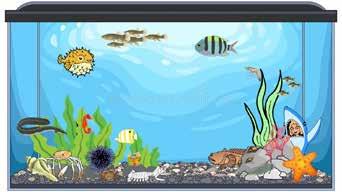

Enjoy a virtual visit to The Wetlands Institute anytime and anywhere by visiting the Aquarium Bytes section of our Virtual Wetlands Experience portal on our website: wetlandsinstitute.org/ aquarium-bytes.
Building Resilience Through Nature-based Solutions to Benefit People and Wildlife
by Dr. Lenore Tedesco, Executive Director
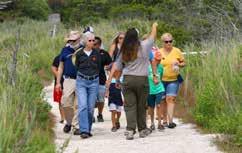
In an effort to continue to showcase the importance and possibilities of innovative solutions that increase resilience, reduce coastal risk, and provide benefits to wildlife and people, TWI is in the process of planning for a second project: to raise the elevation of the Salt Marsh Trail at TWI, restore five additional acres of marsh, and create habitat for nesting diamondback terrapins and marsh-dependent birds.
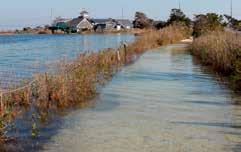
The project design calls for raising the elevation of the Salt Marsh Trail by two to three feet; widening the trail to better accommodate educational programs; replacing the boat house with a modest structure; and creating new high marsh and transitional upland habitat specifically to support nesting terrapins and coastal birds. It will be replanted with native plants designed to maximize the benefit to the marsh ecosystem and the plants and animals that depend on it.
In 2000, our trail flooded twice; in the last 5 years, it has flooded more than 330 times – an average of 67 times per year! This not only impacts access and educational programs but also kills the trees along the path and floods nesting areas used by diamondback terrapins and coastal birds.
The planning phase of this project will be completed early this summer.
Once completed, we will also have created an important barrier to storm waves, conferring additional resilience to the Institute campus. When combined with the Scotch Bonnet Marsh Enhancement Project, we will have added storm protections from wave attack from both the south and east, the primary vulnerabilities for our marsh campus.
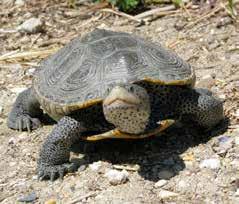
Scotch Bonnet Island Marsh Enhancement Update
by Dr. Lenore Tedesco, Executive Director
The Wetlands Institute, along with our project partners at the US Army Corps of Engineers – Philadelphia District and the NJDEP Fish and Wildlife team, is pleased to report that the construction phase of the project at Scotch Bonnet Island was successfully completed this fall.
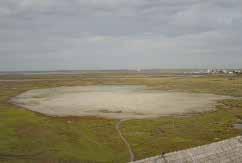
Our goal was to save Scotch Bonnet Island from drowning under the stress of repeated tidal flooding related to accelerating sea level rise, which is submerging tidal marshes. To raise the marsh elevation, we used clean sediment dredged from the NJ Intracoastal Waterway near Nummy Island to enhance
areas that have fallen below the elevation range for healthy marsh.
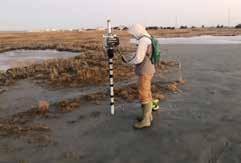
By the completion of construction in December 2024, we had placed 14,000 cubic yards of sand and mud on the marsh, covering an area of 5.5 acres. Upon completion of the placement, the marsh elevation was between 4.2’ NAVD88 and 2’ NAVD88 and the material is greater than 3’ thick in many places. The elevation is slightly higher than we expect it to be when the site settles out more. We achieved all construction goals and are monitoring the site for evidence of performance.
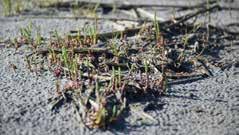
By mid-May, early recolonization of the barren mud surfaces had begun with both Spartina marsh grass and pickleweed sprouting. An unexpected bonus has been site usage for spawning horseshoe crabs near the creek and an abundance of migratory shorebirds that are using the higher ground to rest and feed.
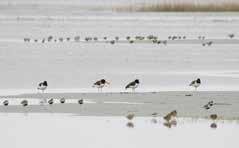

The Marshketeers Notch Another Victory... for the Birds
by Dr. Lenore Tedesco, Executive Director
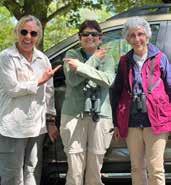
Another World Series of Birding is in the books, and this year’s all ladies Marshketeers birded their way to success under some challenging conditions. Over 20 hours of searching, they identified 124 species, braving persistent strong winds (and 30mph gusts) that kept the birds hunkered down and made finding them particularly difficult. Their search had them in Belleplain State Forest and the marshes at Jake’s Landing in the light of a near-full moon; on sunny, wind-swept beaches on the Atlantic and Delaware Bay; in pockets of Atlantic Maritime Forest preserved in Stone Harbor and Avalon (where they spotted the bonus bird,
the Black-crowned Night Heron); in meadows and dune overlooks in Cape May; and back home at The Wetlands Institute and Stone Harbor Bird Sanctuary. A highlight of the day was a pair of Swallowtailed Kites circling above Cape May Point – a rarity here. Each team member logged more than 20,000 steps, each step reconnecting them to the wonder of Cape May and its importance as a worldrenowned migration corridor hosting one of the great migrations on planet Earth.
Every year, the search takes The Marshketeers to diverse natural habitats and reminds them of the importance and necessity of natural areas for their survival – and for our wellbeing. Thanks to all of you who support our coastal bird conservation programs and enable us to do more to help the incredible at-risk species that nest along our coast.
Back Bay Birding and Wildlife Tours
Board The Skimmer to cruise the beautiful back bays of Stone Harbor. Highlights include bird watching, salt marsh wildlife viewing, and marine life touch tanks. Trips depart weekly, with both daytime and evening tours available. Call 609-884-3100 for reservations or book online at skimmer. com.
Back Bay Kayaking Kayaking has become a very popular way to explore the marsh. Join us for a guided kayak tour of the coastal marsh ecosystem in a single or tandem kayak. Call 609-368-1211 for reservations.
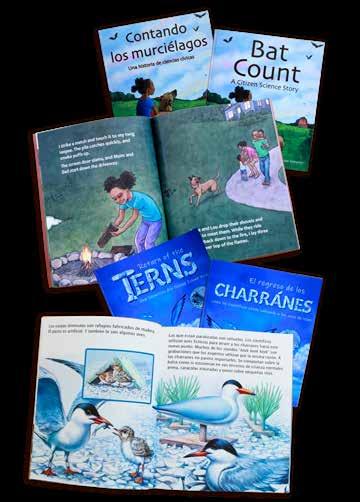
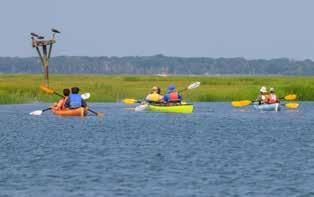
Reservations required for all activities. Please check our website for complete schedule and pricing. Unless otherwise stated, all activities leave from The Wetlands Institute dock.
Tidepool Shop
Helping people make connections to nature is at the heart of everything we do, and this extends to the items we offer in the Tidepool Shop. Our gift shop features a variety of thoughtfully currated nature-themed books, games, and gifts that spark curiosity, fire the imagination, and encourage exploration and discovery. We are always on the lookout for new and engaging science-based material that reflects the wonders of the world around us. With every purchase you can be assured that you have accurate information that educates and inspires.
The Tidepool Shop has recently added a collection of wonderful new books (along with some old favorites) that bring readers and listeners alike on journeys of discovery as they delve into the lives of some of our amazing local critters –and we’re excited to offer Spanish-language versions, too! Stop in and explore our excellent selection of games and puzzles as well – they’re sure to add to your family’s fun at the shore.
Visit the Tidepool Shop and bring a new adventure home today! As always, your purchase directly supports our important work here at The Wetlands Institute.
thank you!
Our book and gift shop is open every day from 9:30am to 4:30pm. Can’t visit us? Give us a call or browse online at tidepool-shop.myshopify.com 24/7!
A non-profit organization studying, preserving, and protecting wetlands and coastal ecosystems 1075

As a conservation organization, we have a special responsibility to address the global challenges of climate change and sustainability. We are committed to minimizing environmental impacts in all aspects of our operations. Visit our website at wetlandsinstitute.org/about-us/ sustainability/ for more on our sustainability initiatives.

